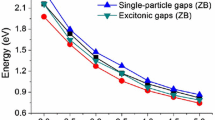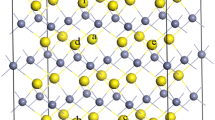Abstract
A theoretical study of crystal field parameters (CFP) and zero-field splitting (ZFS) parameter D of Mn2+ doped zinc sulfide (ZnS) nano crystals is carried out with the help of superposition model and the perturbation theory. The ZFS parameter D obtained here is in good agreement with the experimental value reported earlier. The conclusion of experimental study that Mn2+ substitutes for Zn2+ in ZnS is well supported by our theoretical investigation. The values of D without and with local distortion are 65 × 10−4 and 71 × 10−4 cm−1, respectively, while the experimental value is 66 × 10−4 cm−1.

Similar content being viewed by others
References
Abragam A, Bleaney B (1970) Electron paramagnetic resonance of transition ions. Clarendon Press, Oxford
Anandlakshmi H, Velavan K, Sougandi I et al (2004) Single crystal EPR studies of Mn2+ doped into zinc ammonium phosphate hexahydrate: a case of interstitial site for bio-mineral analogue. Pramana 62:77–86
Anthonisamy VSX, Velayutham M, Murugesan R (1999) Spin-lattice relaxation of Co(II) in hexaaquocobalt(II) picrylsulphonate tetrahydrate: An estimate from EPR line width of the dopant, Mn(II). Phys B 262:13–19
Edgar A (1976) Electron paramagnetic resonance studies of divalent cobalt ions in some chloride salts. J Phys C 9:4303–4314
Gnutek P, Yang ZY, Rudowicz C (2009) Modeling local structure using crystal field and spin Hamiltonian parameters: the tetragonal Fe–O defect center in KTaO3 crystal. J Phys Condens Matter 21:455402–455412
Hoa TTQ, The ND, Mc Vitie S et al (2011) Optical properties of Mn-doped ZnS semiconductor nanoclusters synthesized by a hydrothermal process. Opt Mat 33:308–314
Kripal R, Gupta AK (2010) EPR and Optical studies of ZnS: Mn nanoparticles. Chalcogenide Lett 7:203–209
Kripal R, Mishra V (2005) EPR and optical study of Mn2+ doped potassium hydrogen sulphate. Solid State Commun 133:23–28
Kuska HA, Rogers MT (1968) Radical ions. In: Kaiser ET, Kevan L (eds) Interscience, New York
Macfarlane RM (1967) Zero field splittings of t 32 cubic terms. J Chem Phys 47:2066–2073
Macfarlane RM (1970) Perturbation methods in the calculation of Zeeman interactions and magnetic dipole line strengths for d3 trigonal-crystal spectra. Phys Rev B 1:989–1004
Mc Garvey BR (1966) Electron spin resonance of transition metal complexes. In: Carlin RL (ed) Transition metal chemistry, vol 3. Marcel Dekker, New York
Misra SK (1994) Estimation of the Mn2+ zero-field splitting parameter from a polycrystalline EPR spectrum. Phys B 203:193–200
Misra SK (1999) Handbook of ESR, vol. 2. Poole CP Jr, Farach HA (eds). Springer, New York, Chapter IX, p. 291
Natarajan S, Mohana Rao JK (1976) The crystal structure of diglycine calcium chloride tetrahydrate. Curr Sci 45:490–491
Newman DJ, Ng B (1989) The superposition model of crystal fields. Rep Prog Phys 52:699–763
Newman DJ, Pryce DC, Runciman WA (1978) Superposition model analysis of the near infrared spectrum of Fe2+ pyrope almandine garnets. Am Mineral 63:1278–1281
Powell MJ, Gabriel DJR, Johnston DF (1960) Ground-state splitting for d5 6S ions in a cubic field. Phys Rev Lett 5:145–146
Pryce MHL (1950) Spin–spin interaction within paramagnetic ions. Phys Rev 80:1107–1108
Radnell CJ, Pilbrow JR, Subramanian S et al (1975) Electron paramagnetic resonance of Fe3+ ions in (NH4)2SbF5. J Chem Phys 62:4948–4952
Rao PS (1993) Single crystal EPR studies of Mn2+ doped magnesium potassium Tutton’s salt. Spectrochim Acta A 49:897–901
Rudowicz C, Misra SK (2001) Spin-Hamiltonian formalisms in electron magnetic resonance (EMR) and related spectroscopies. Appl Spectrosc Rev 36:11–63
Rudowicz C, Sung HWF (2001) Can the electron magnetic resonance (EMR) techniques measure the crystal (ligand) field parameters? Phys B 300:1–26
Sharma RR, Orbach R, Das TP (1966) Zero-field splitting of S-state ions. I. Point-multipole model. Phys Rev 149:257–269
Shen GY, Zhao MG (1984) Analysis of the spectrum of Fe2+ in Fe-pyrope garnets. Phys Rev B 30:3691–3703
Singh KD, Jain SC, Sakore TD et al (1975) The crystal and molecular structure of zinc lactate trihydrate. Acta Cryst B31:990–993
Watanabe H (1957) On the ground level splitting of Mn++ and Fe+++ in nearly cubic crystalline field. Prog Theor Phys 18:405–420
Wei Q (2010) Investigation of optical and EPR spectra for Cr3+ ions in diammonium hexaaqua magnesium sulphate single crystal. Acta Phys Polon A 118:670–672
Weil JA, Bolton JR (2007) Electron paramagnetic resonance: elementary theory and practical applications, 2nd edn. Wiley, New York
Wyckoff RWG (1963) Crystal Structure. Interscience Publisher, New York
Yang ZY (2000) An investigation of the EPR zero-field splitting of Cr3+ ions at the tetragonal site and the Cd2+ vacancy in RbCdF3:Cr3+ crystals. J Phys Condens Matter 12:4091–4096
Yang ZY, Rudowicz C, Yeung YY (2004a) Microscopic spin-Hamiltonian parameters and crystal field energy levels for the low C3 symmetry Ni2+ centre in LiNbO3 crystals. Phys B 348:151–159
Yang ZY, Hao Y, Rudowicz C et al (2004b) Theoretical investigations of the microscopic spin Hamiltonian parameters including the spin–spin and spin–other-orbit interactions for Ni2+(3d8) ions in trigonal crystal fields. J Phys Condens Matter 16:3481–3494
Yeom TH, Choh SH, Du ML (1993) A theoretical investigation of the zero-field splitting parameters for an Mn2+ centre in a BiVO4 single crystal. J Phys Condens Matter 5:2017–2024
Yeom TH, Chang YM, Choh SH et al (1994) Experimental and theoretical investigation of spin-hamiltonian parameters for the low symmetry Fe3+ centre in LiNbO3. Phys Stat Sol B 185:409–415
Yeung YY (2013) Superposition model and its applications. In: Brik MG, Avram NM (eds) Optical properties of 3d-ions in crystals, spectroscopy and crystal field analysis (Chapter 3). Springer, Heidelberg, pp 95–121
Yeung YY, Newman DJ (1986) Superposition model analysis for the Cr3+ 4A2 ground state. Phys Rev B 34:2258–2265
Yu WL (1989) Cubic zero-field splitting of a 6state ion. Phys Rev B 39:622–632
Yu WL, Zhao MG (1984) Determination of the crystalline structure of Mn2+:CaZnF4 by EPR and optical spectra of Mn2+. J Phys C Solid State Phys 17:L525–L527
Yu WL, Zhao MG (1987) Zero-field splitting and the d–d transitions of Mn2+ on Ca(II) sites in Ca5(PO4)3F. Phys Stat B 140:203–212
Yu WL, Zhao MG (1988) Theory of deep inelastic neutron scattering on quantum fluids. Phys Rev B 37:9254–9267
Zhao MG, Du ML, Sen GY (1985) The eighth-order perturbation formula for the EPR cubic zero-field splitting parameter of d5 (6S) ion and its applications to MgO: Mn2+ and MnCl2·2H2O. J Phys C Solid State Phys 18:3241–3248
Author information
Authors and Affiliations
Corresponding author
Rights and permissions
About this article
Cite this article
Kripal, R., Yadav, A.K. Modeling of Mn2+ Doped Zinc Sulfide Nano Crystals. Iran J Sci Technol Trans Sci 42, 2319–2322 (2018). https://doi.org/10.1007/s40995-017-0146-8
Received:
Accepted:
Published:
Issue Date:
DOI: https://doi.org/10.1007/s40995-017-0146-8




